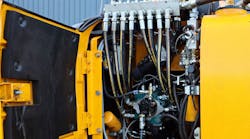High-Speed Solenoid Valves Control Hydraulic Pump Displacement
Much of the mobile equipment in use today operates with conventional hydraulic pumps controlled by changing the stroke of pistons with a swashplate mechanism. Because swashplate position is not easily controlled, energy is lost through volumetric and mechanical inefficiencies. A new technology, the Digital Displacement Pump overcomes these limitations by using multiple radial cylinders that are enabled and disabled in real time with ultra-fast mechatronic valves controlled by an embedded computer.
Developed by Artemis Intelligent Power Ltd., Loanhead, Scotland, the technology has shown a substantial energy savings by making it practical to replace mechanical gearboxes with hydraulic transmissions. Benefits include lower energy usage, typically less than one-third that of a conventional axial-piston pump, quicker response times, and elimination of high-frequency noise. When applied to an excavator, for example, the technology has demonstrated fuel savings of up to 20%, as well as an increase in productivity of nearly 30%.
How it Works
The Digital Displacement Pump (DDP) is a radial-piston pump with cylinders stroked by a cam ring. Each cylinder can be turned on and off individually, and each has its own control system: solenoid-operated poppet valve, a check valve, and a piston position sensor. When configured as a Digital Displacement Pump Motor (DDPM), each piston has two solenoids, and the unit can be used as a pump or a motor. These solenoids can be activated or deactivated in as little as 30 msec to limit oil flow through each cylinder as the load requires. In essence, it is a multi-step transmission with each step capable of varying its output flow.
The decision to activate or deactivate a given cylinder is made continually with each shaft revolution to meet the pressure demand set in the pump controller. The number, orientation, and size of the pistons in use can vary widely. A common configuration uses 12 cylinders arranged in three groups of four, although the manufacturer has built a unit with 68 pistons for a wind turbine application.
This graph compares efficiency of the Digital Displacement Pump with a variable-displacement axial-piston pump at two different speeds.
The DDP and DDPM are designed to be computer-controlled. To take full advantage of the technology, it is critical to adjust the timing of the solenoids based on signals from the piston position sensors and feedback from the work site. With the shaft rotating, if the load does not require flow, all cylinders are isolated from any line pressure and incur minimal losses. From the idle state, full flow can be achieved within 30 msec, independent of working pressure. In addition, a DDP can be powered with an induction motor and a soft starter, reducing initial cost when compared to using a variable-speed motor used with an axial-piston pump.
Solenoid Timing Varies Flow
The simplified circuit diagrams of a six-piston pump show how the technology works. As the cam rotates, the pistons are alternately drawn in and pushed out. A check valve separates the high- and low-pressure areas of the pump, and a solenoid valve opens and closes the path from the low-pressure area. This allows for treating each pump cylinder as an individual source.
Simplified diagram of a six-piston Digital Displacement Pump shows no-flow condition with solenoids de-energized.
When no solenoid valves are energized, the low-pressure source remains available to the piston during the complete revolution of the cam. The piston simply cycles fluid out and back in to the low-pressure core. Because it is effectively taken out of the circuit, it requires very little energy. In the event of electrical power failure, the DDP fails to a no-flow, low-pressure condition. When a solenoid valve is energized, the piston draws from the low-pressure core and then exhausts into the high-pressure core.
As an example of how the technology works, if each of the six pistons has a displacement of 0.61 in3 (10 cm3), total displacement would be 3.7 in3 (60 cc). At 1,800 rpm, the flow potential would be 28.5 gpm (108 lpm). As each piston is put in service when its control solenoid is energized, the potential flow is increased by 4.8 gpm (18 lpm). If part of a work cycle requires only 14.3 gpm (54 lpm), only three of the solenoids can be energized strategically to produce the required output.
Simplified diagram of a six-piston Digital Displacement Pump with solenoids energized in full-flow condition.
Energizing the solenoids also can be timed differently so that only a portion of the piston displacement is sent to the high-pressure core. Using the same six-piston pump example, if the flow demand is 16.6 gpm (63 lpm), the displacement of 3½ pistons would be required. This could be accomplished by energizing three solenoids to put three pistons in service and one solenoid to close the path to the low-pressure side as the piston reached half stroke. This would cause half of the piston’s displacement to enter the pressure stream.
Another approach would be to provide an average flow per minute by energizing all the solenoids for 1,044 revolutions and then leaving them de-energized for 756 revolutions. If these approaches cause unwanted power ripples, the same flow could be achieved by timing each of the six solenoids to cause the pistons to displace only 5.8 cc per cycle by turning them on at 58% of the stroke. The DDP can mimic an infinitely variable displacement pump closely without maintaining a constant core pressure. The individual pistons can be at inlet pressure regardless of the pressure at the outlet of the pump.
In addition, the output of each piston can be isolated so the pump can provide flow to multiple circuits. In the example, six separate functions could be fed from one single DDP, each with varying flow up to 4.8 gpm (18 lpm).





